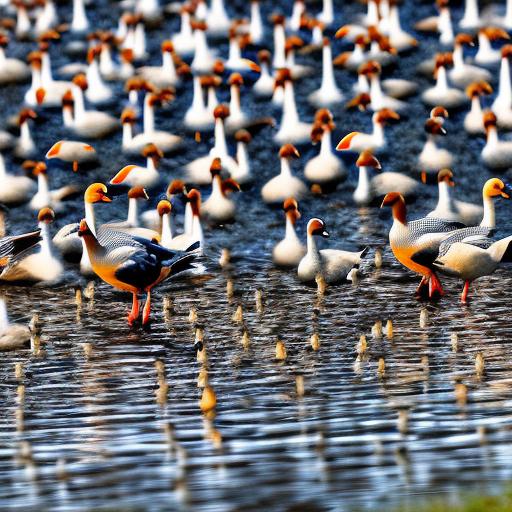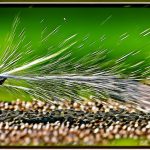Geese are known for their strong migratory instincts and their tendency to return to the same nesting and feeding grounds year after year. They are social birds that often travel in flocks and are highly protective of their young. Geese are also known for their aggressive behavior, especially during nesting season when they may become territorial and defensive. Understanding these behaviors is crucial when it comes to managing and deterring geese from unwanted areas.
Geese are attracted to areas with ample food sources, open water, and suitable nesting sites. They are also drawn to areas with short grass, as it provides them with a clear line of sight to spot potential predators. Geese are also known to be sensitive to noise and visual stimuli, which can be used to deter them from specific areas. By understanding these behaviors, property owners can implement effective strategies to discourage geese from congregating in unwanted areas.
Key Takeaways
- Geese are social birds and exhibit protective behavior, especially during nesting season.
- Physical barriers such as fences and netting can effectively prevent geese from accessing certain areas.
- Sound deterrents like propane cannons and ultrasonic devices can disrupt geese and discourage them from staying in an area.
- Visual deterrents such as scarecrows and reflective tape can make geese feel uncomfortable and encourage them to leave.
- Removing food sources like grass clippings and spilled birdseed can help reduce the attractiveness of an area to geese.
- Landscaping techniques like planting tall grasses and shrubs can create an unappealing environment for geese to nest.
- Seeking professional help from wildlife management experts can provide effective and humane solutions for managing geese populations.
Creating physical barriers
One of the most effective ways to deter geese from a specific area is by creating physical barriers that prevent them from accessing the space. This can include installing fences, hedges, or other structures that block geese from entering the area. Fences can be particularly effective when placed around bodies of water or other areas where geese tend to congregate. Additionally, installing barriers such as netting or wire grids over grassy areas can prevent geese from feeding on the vegetation.
Another physical barrier that can be effective in deterring geese is the use of floating barriers on bodies of water. These barriers can be placed strategically to prevent geese from accessing certain areas while still allowing other wildlife to move freely. By creating physical barriers, property owners can effectively discourage geese from settling in unwanted areas and minimize the damage they can cause.
Implementing sound deterrents
Sound deterrents can be an effective way to discourage geese from congregating in specific areas. Geese are sensitive to loud noises and unfamiliar sounds, which can make them uncomfortable and encourage them to move on to quieter locations. There are a variety of sound deterrents that can be used to discourage geese, including propane cannons, sonic devices, and recorded distress calls of geese or other birds.
Propane cannons emit loud, explosive sounds at regular intervals, which can startle geese and encourage them to seek quieter areas. Sonic devices emit high-pitched noises that are unpleasant for geese and can deter them from settling in specific locations. Recorded distress calls of geese or other birds can also be effective in discouraging geese from congregating in certain areas. By implementing sound deterrents, property owners can effectively discourage geese from settling in unwanted areas without causing harm to the birds.
Using visual deterrents
Visual deterrents can be an effective way to discourage geese from settling in specific areas. Geese are sensitive to visual stimuli and may be deterred by objects or patterns that they perceive as threatening or unfamiliar. There are a variety of visual deterrents that can be used to discourage geese, including predator decoys, reflective tape, and scarecrows.
Predator decoys, such as fake coyotes or dogs, can be effective in deterring geese by creating the illusion of a potential threat. Reflective tape can also be effective in deterring geese by creating flashes of light and movement that make them uncomfortable. Scarecrows can be effective in deterring geese by creating the illusion of a human presence, which can make them feel threatened and encourage them to move on to quieter locations. By using visual deterrents, property owners can effectively discourage geese from settling in unwanted areas without causing harm to the birds.
Removing food sources
Geese are attracted to areas with ample food sources, so removing these sources can be an effective way to discourage them from settling in specific locations. This can include removing or reducing access to grassy areas, especially those with short grass that is ideal for grazing. Property owners can also implement landscaping techniques that make it more difficult for geese to access food sources, such as planting tall grasses or shrubs around bodies of water.
Additionally, property owners can implement measures to prevent geese from accessing human-provided food sources, such as securing garbage cans and cleaning up spilled food. By removing food sources, property owners can effectively discourage geese from settling in unwanted areas and minimize the damage they can cause.
Implementing landscaping techniques

Landscaping techniques can be an effective way to discourage geese from settling in specific areas. By implementing landscaping features that make it less attractive for geese to congregate, property owners can effectively discourage them from settling in unwanted locations. This can include planting tall grasses or shrubs around bodies of water, which can make it more difficult for geese to access food sources and nesting sites.
Additionally, property owners can implement landscaping features that create physical barriers or obstacles for geese, such as installing rocks or boulders around bodies of water or other areas where geese tend to congregate. By implementing landscaping techniques, property owners can effectively discourage geese from settling in unwanted areas and minimize the damage they can cause.
Seeking professional help
In some cases, deterring geese from specific areas may require the expertise of professionals who specialize in wildlife management. Professional wildlife management companies have the knowledge and experience to assess the situation and implement effective strategies for deterring geese without causing harm to the birds. These professionals may use a combination of physical barriers, sound deterrents, visual deterrents, and landscaping techniques to effectively discourage geese from settling in unwanted areas.
Additionally, professional wildlife management companies may have access to specialized equipment and resources that can be used to deter geese effectively. By seeking professional help, property owners can ensure that they are implementing the most effective strategies for deterring geese and minimizing the damage they can cause.
In conclusion, understanding the behavior of geese is crucial when it comes to managing and deterring them from unwanted areas. By implementing a combination of physical barriers, sound deterrents, visual deterrents, removing food sources, implementing landscaping techniques, and seeking professional help, property owners can effectively discourage geese from settling in specific locations and minimize the damage they can cause.
Looking for safe ways to keep geese out of your yard? Check out this helpful article on PoultryWizard for tips and tricks to deter geese without causing harm. Whether it’s using natural deterrents or creating barriers, this article provides practical and humane solutions to keep your yard goose-free.
FAQs
What are some safe ways to keep geese out of your yard?
Some safe ways to keep geese out of your yard include using visual deterrents such as scarecrows or reflective objects, installing fencing or netting, using natural repellents like citrus or garlic, and creating barriers with landscaping features.
Are there any non-lethal methods to deter geese from entering my yard?
Yes, there are several non-lethal methods to deter geese from entering your yard. These include using visual deterrents, installing fencing or netting, using natural repellents, and creating barriers with landscaping features.
Is it legal to harm or kill geese to keep them out of my yard?
In many places, it is illegal to harm or kill geese as they are protected under wildlife conservation laws. It is important to use non-lethal methods to deter geese from entering your yard.
What are some natural repellents that can be used to keep geese out of the yard?
Some natural repellents that can be used to keep geese out of the yard include citrus-based sprays, garlic-based sprays, and predator urine. These repellents can help deter geese without causing harm to the birds.
How effective are visual deterrents in keeping geese out of the yard?
Visual deterrents can be effective in keeping geese out of the yard, especially when used in combination with other methods. Scarecrows, reflective objects, and other visual deterrents can help make the yard less inviting to geese.
Meet Walter, the feathered-friend fanatic of Florida! Nestled in the sunshine state, Walter struts through life with his feathered companions, clucking his way to happiness. With a coop that’s fancier than a five-star hotel, he’s the Don Juan of the chicken world. When he’s not teaching his hens to do the cha-cha, you’ll find him in a heated debate with his prized rooster, Sir Clucks-a-Lot. Walter’s poultry passion is no yolk; he’s the sunny-side-up guy you never knew you needed in your flock of friends!







